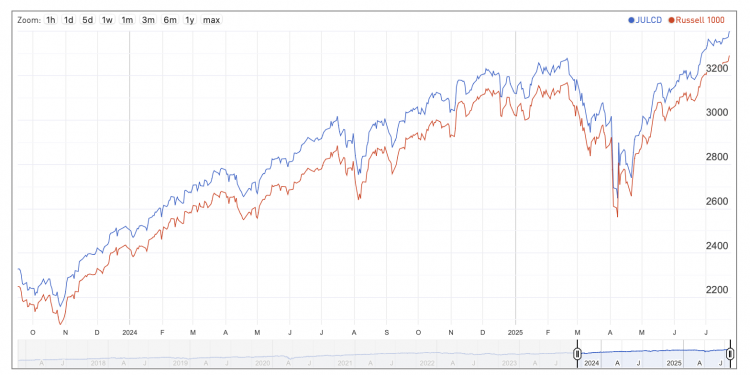With Recession Fears Rising, Companies Can (And Should) Be Investing in JUST Jobs

A recent headline I appreciated (and chuckled at a bit) notes companies are “hoarding” workers. The economic term is apt for how companies traditionally have approached their workforce: a cost to be managed. And so in the early days of the pandemic, with so much uncertainty, the answer was to lay off mass numbers of people to conserve capital. Yet, two and a half years later, we’re still paying for that decision in non-resilient supply chains, ill-trained workers, and ongoing turnover costs.
I’m often asked if I think the pandemic changed how companies fundamentally see their workers, and, with a potential recession oncoming, if we’re sliding toward business as (pre-pandemic) usual. The hoarding phenomenon is one example that I believe implies some fundamental conventional wisdom may be changing in favor of an emerging business strategy that: 1. Acknowledges that human capital can be a source of value creation, and that replacing that capital costs a lot in terms of productivity, recruitment costs, and institutional knowledge, and 2. Reflects a growing awareness that workers are more than capital, that investing in people can lead to strong, positive culture changes, and that underinvesting in human capital (or ignoring it altogether) can leave companies vulnerable to consumer and worker pressure.
Of course, this approach isn’t new, and didn’t emerge with the pandemic. Yet, for those of us who are focused on the momentum of the last couple of years around jobs and worker value, there’s an urgency to ensuring that trend continues, and we don’t return to pre-pandemic normal. The American people believe, and share that urgency. JUST Capital continues to see polling on how intensely they want to see companies invest in their workers.
It’s part of the reason we recently launched our JUST Jobs program. JUST Jobs is meant to highlight how companies are acting on the lessons from the past two and half years on the importance of workers – and which ones haven’t lived up to the rhetoric. Concerns about a potential recession and inflation make these questions more urgent. I spoke last week at CNBC’s Workforce Executive Council, where conversation focused on how to manage worker issues in a turbulent time. Knowing that this question is at the top of many people’s minds, and that simultaneously there’s significant work underway to secure the progress that’s been made, I wanted to observe and connect the dots around what’s currently happening.
JUST Capital is in a lot of rooms with different economic players, from corporate leaders to investors to civil society leaders. I’ve come to think about the work underway, and what needs to happen, in three buckets: the definition of a good or “just” job, the measurement of a good job, and the investment in creating good jobs.
Each bucket has seen different levels of progress recently. We spoke with some of the largest U.S. companies to gauge their reactions and thoughts on the work underway and what’s still to come, and have collected an overview of what we’ve found.
Defining a good job
The Aspen Institute and Families and Workers Fund spearheaded a process over the last six months to define what a good job is, recently launched as the Good Jobs Champions Group’s Statement on Good Jobs and Working Definition. We were excited to facilitate corporate conversations that informed the multi-stakeholder-based definition, led by Kelley Frances Fenelon, our Director of Programs and Engagement. There is other work underway, from additional survey work of Americans to listening directly from workers on what constitutes a good job. I believe that in the next six months or so, we’ll have far additional clarity and shared language around what constitutes a good job.
And in the meantime, it’s useful to pause and lift up the elements of the Good Jobs Champions Group’s Working Definition that found clear resonance within our facilitated corporate conversations and aligned with corporate leaders’ priorities – as well as notice where there are sticking points or differences in approach. Most importantly, company representatives were excited to see a “North Star” understanding of job quality that could inspire action across different companies in different industries. Shared language, they agreed, is inherently helpful, even as businesses will tailor any good job definition’s component parts to align with their unique employee value proposition.
But moving beyond the usefulness of a definition in general, what did they like about this one? By focusing on three thematic areas – economic security, economic mobility, and equity, respect, and voice – the working definition acknowledges that no single aspect can address the whole of job quality. Instead, high-profile (and certainly important) aspects of job quality like compensation are rightly portrayed as one part of a larger puzzle. That point came up time and again, as company representatives across industries expressed appreciation for the definition’s inclusive approach.
A few elements of the definition also stood out as forward-looking to companies as they race to define how they’ll attract, develop, and retain the right employees. While the table stakes issues that provide for workers’ economic security can’t be ignored, the corporate representatives emphasized that it’s increasingly important for companies to demonstrate that individual employees are valued and integral to the success of the organization. That can look like being meaningfully included in operational decisions that impact their role, supported with leave and benefits policies, and invested in as an individual who has room to grow within the organization.
Another emerging focus for companies is attention to wealth-building opportunities so that, as one representative put it, people can go beyond surviving to thriving. Company leaders pointed to wealth-building opportunities as a leading advantage for employers of choice with initiatives like financial literacy education, retirement savings, employee stock ownership programs, and education and training for career advancement.
And yet, company representatives noted that any good jobs definition will, by nature, paint with a broad brush, thereby making it difficult at times to see how some elements apply across the workforce. Should all positions offer employee stock ownership? How do fair scheduling practices apply to a salaried managerial or even executive leadership role? In a sense, these questions ask: For whose jobs are these definitions meant? A counterpoint was raised by several company representatives as well – the definition usefully signals the importance of job quality features that are not yet commonplace across the U.S. workforce, and demands thoughtfulness about what employees at all levels of a company should expect from their job.
In doing so, the Good Jobs Champions Group’s Working Definition allows companies to prioritize the future of work at their organization in the midst of a highly competitive talent environment by creating jobs that, as one participant hoped, really make people want to stick around.
Ultimately, however, a job quality definition is only as good as it is useful, and those we spoke with saw how this one could be carried forward and put into action. From being used as an internal tool to advance conversations about workforce initiatives, to providing a point of reference in comparison with an existing employee value proposition, to even serving as an accountability mechanism to check internal priorities, most company representatives could immediately envision how they’d use the definition. They were also eager to see what might be built beyond the definition to capture context (e.g., how key elements like good managers and robust, diverse employee pipelines come into play) and inform improving practice (e.g. benchmarking tools and leading practice examples).
Those hopes for what’s to come align with my own sense for what’s needed. Once we have a definition, how do we capture whether companies are living up to its promise?
Measuring a good job
There are two things needed to measure a good job: Agreement on specifically what to measure, so that everyone can benchmark and track according to the same metrics and the data itself.
I was on a panel last week that Jobcase hosted, with the Rise Fund and the Burning Glass Institute. The three of us functionally represented three kinds of data: Publicly disclosed, private, and crowdsourced. This means what we’re measuring could focus on disclosure of certain policies and practices or outcomes of those activities. This is one of the elements that we and others will continue to work through – how do we best construct metrics that recognize the unique, and complementary, value of different datasets.
The U.S. Department of Labor has also been facilitating a similar dialogue (we’ve been honored to co-lead the workstream on corporate data) on how to integrate different sets of data from different sources to create a holistic view of jobs. So there is some progress on aligning these approaches to measuring good jobs, or at least getting much clearer on what the differences are and how to use each appropriately.
On access to data, we are seeing momentum in a couple of areas, including last week’s release of the American Opportunity Index. What’s important about this index is that it’s one of the first times that crowdsourced data is standing on its own to assess companies relative to each other. It speaks to how much data has now been aggregated from job sites and other places so that research organizations can begin to use employees’ own, self-reported data to track real workers and their progress.
On the public disclosure side, rates are still quite low. JUST Capital did a recent assessment on the workforce data that we use in our Rankings, and it shows that much data disclosure is below 50%, and for data that investors and researchers really want (turnover rates, total workforce compensation, training costs) that number is much lower. According to an assessment JUST Capital did a year ago, most were less than 10% or even 5%.
As for jobs strategy at private companies, we’ve been part of several conversations recently in which we discussed with investors, like those in private equity, ways they can determine which businesses are implementing a good jobs strategy – and invest accordingly. So stay tuned for more on that, too.
Creating good jobs
Finally, and most crucially, none of this matters if we don’t see movement on the creation of good jobs.
Our main message to companies on creating good jobs is to start with some fundamental questions. These questions are applicable regardless of industry, type of workforce, and more. I spoke at Slack’s Future Forum event this week and I suggested executives ask four main questions about their workforce, with a particular focus on frontline workers:
- Are your workers reasonably able to cover their monthly expenses? Are they able to save? How many of your workers have access to basic benefits? How many are using them?
- Are workers able to advance within your organizations? For whom is it easier and more difficult? Consider varying levels, demographics of workers, etc.
- Do working caregivers have the flexibility they need to do their best work while navigating at-home responsibilities? Are people taking advantage of those policies?
- Is there diverse representation across job levels? At the executive and board levels?
Once you have the answers, start to align how to address those questions with your business strategy. These questions are how JUST Capital orients our programmatic work, as well. It’s why JUST Capital and PayPal, in partnership with the Financial Health Network and the Good Jobs Institute, launched the Worker Financial Wellness Initiative to support companies as they decide which questions to ask first and how they’ll go about answering them. JUST Capital will also be launching a cohort on racial equity in the coming months.
One company may make different choices about how to address the results of the questions, and at the end of the day, a workforce strategy, along with a stakeholder capitalism and purpose strategy, must align with operational strategy. Otherwise, it often simply becomes noise, and the first thing to cut.
Role of investors, workers, and the government
We’re seeing significant movement both from investors and workers on the topic of good jobs. Both State Street and BlackRock are putting an increasing focus on how companies should think about their human capital strategy. The Human Capital Management Coalition, a group of institutional investors representing over $8 trillion in assets that is co-chaired by our Head of Investor Strategies, Cambria Allen-Ratzlaff, continues to push companies for fundamental workforce disclosure data. And, as ESG has become seen as political, the “S” or Social issues, continue to be built out as an example of a real value driver (something I wrote about at the beginning of this year).
Workers themselves are also starting to apply real pressure. Whether it’s organizing unionization pushes, leveraging social media to highlight workplace conditions, or refusing to remain in a workplace that doesn’t provide quality jobs or access to opportunity, workers are increasingly feeling empowered to speak up when they feel like their employers aren’t living up to their expectations.
Finally, governments have taken more of an active role. In California, the legislature recently passed a law essentially establishing a workforce council for the fast food industry. The SEC has also continued to signal that it will take up human capital disclosure soon. At a recent SEC Investor Advisory Committee, two JUST Capital colleagues presented on the importance of human capital.
JUST Capital and JUST Jobs
JUST Capital believes in the catalytic effect of large companies through their own footprint and that of their suppliers. We work with the largest publicly-traded companies in the United States, which employ around 20 million people. According to our recent assessment, half of those people do not make a family-sustaining living wage. Wages and compensation are obviously one core element of a good job. We launched the JUST Jobs program to focus directly on those 10 million people through this program, and indirectly the lives of the 160 million people who are employed in the United States.
Defining, measuring, and creating JUST Jobs is core to the program. The primary tool we’ll employ in this effort is a JUST Jobs Scorecard, which will track elements of a good job year-over-year using publicly available data, and show how each company stacks up relative to their peers. The Good Jobs Champions framework noted above is influencing what we measure, along with our and others’ polling work. We’ll be using the Scorecard to show companies where they can improve for their workers, and work with other nonprofits that are experts on specific elements of that on further improvement recommendations.
We’ll also continue to share the business benefits for an investment in good jobs. We’ll uplift research that continues to show that investing in workers leads to better productivity, lower absenteeism, more innovation, and lower turnover costs. We’ll partner with academics and others to continue to interrogate and highlight these facts.
We’re focusing on this topic at this moment because there is urgency to ensure that we don’t unlearn the lessons of the last several years. And the American people are very clear, according to a number of recent surveys conducted by JUST Capital, that this is the issue that companies should be focused on.






